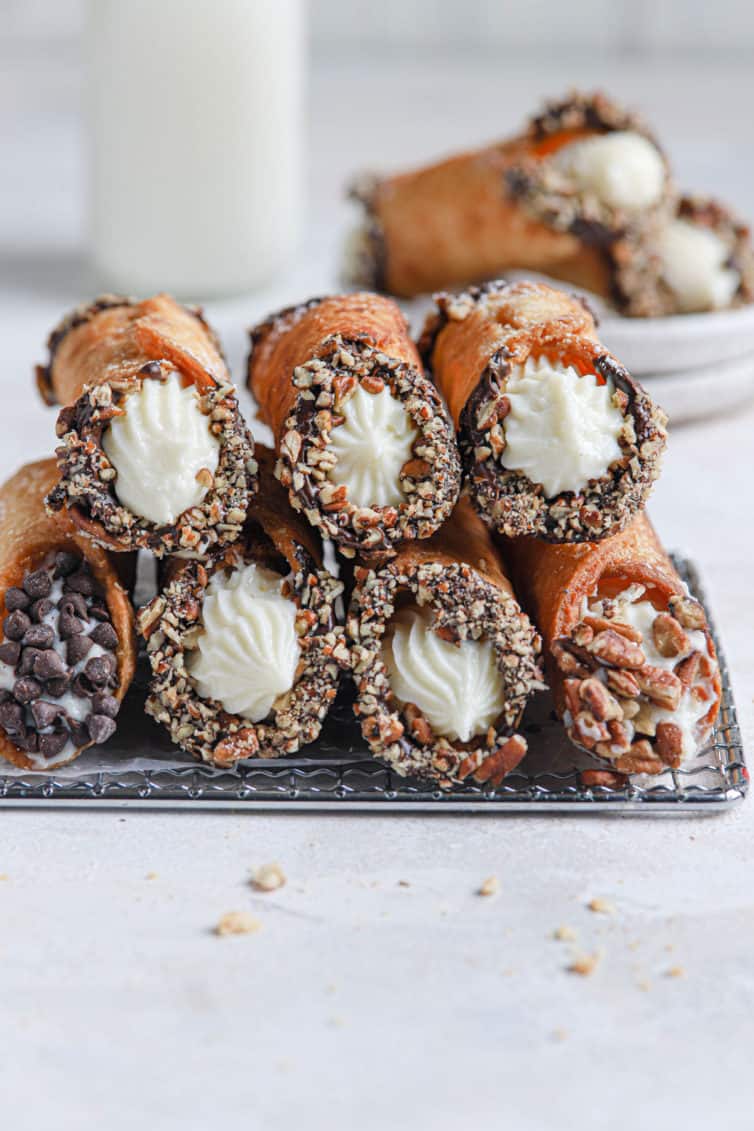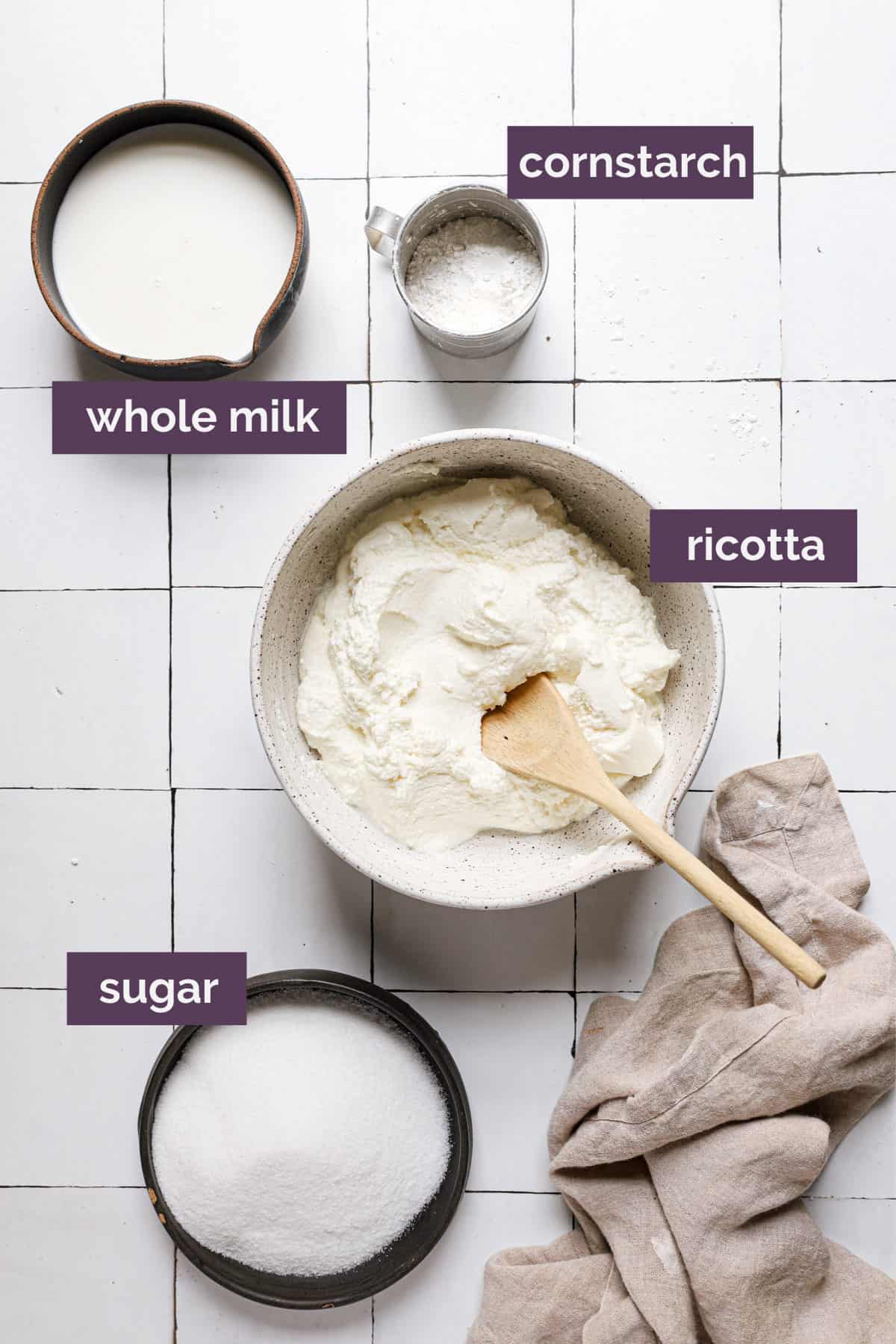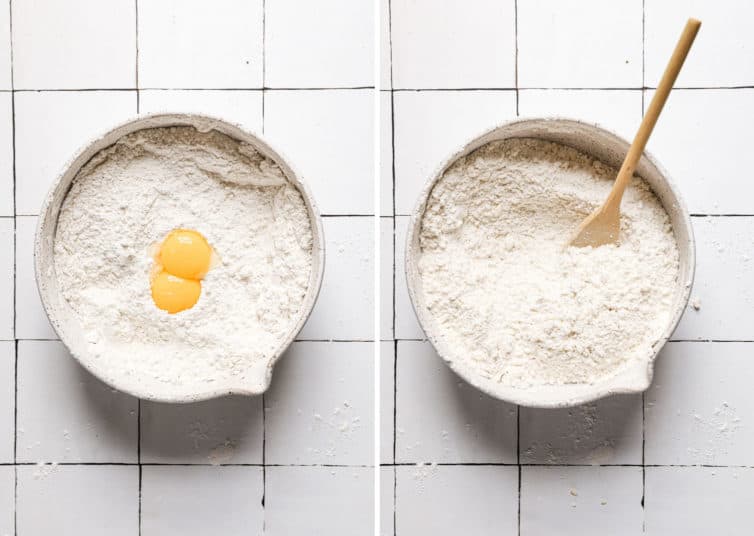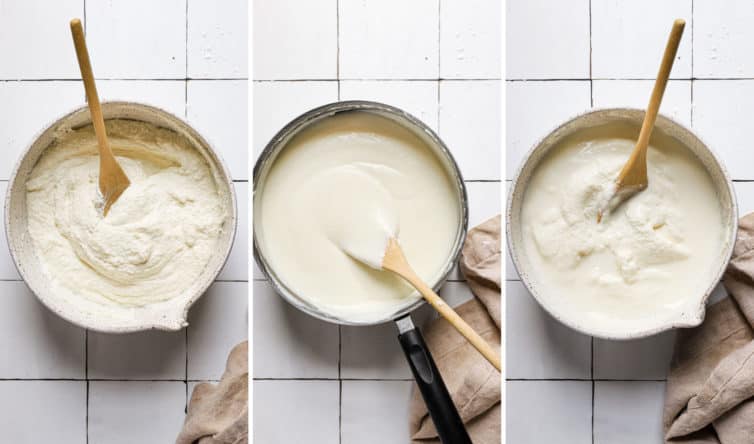Homemade Cannoli
Light and crispy cannoli shells filled with a sweet, creamy ricotta filling make these homemade cannoli an absolute treat. Learn how to make cannoli from shell to filling for a family-favorite recipe you will want to make again and again.

This recipe is super special to me, as it hails from my husband’s family. I had enjoyed cannoli many, many times, but I never knew anyone who actually made the whole pastry (shells AND filling!) completely from scratch. Not only were the shells and filling homemade, but my husband’s grandfather used to work at an aluminum plant and crafted the cannoli forms himself!
Over 10 years ago, on New Year’s Eve day, we gathered at my in-laws’ house to make cannoli. I watched his Nana roll out the dough and wrap it meticulously around the forms, watched his dad stir the filling patiently, and then got to enjoy the fruits of their labor.
What are Cannoli?
If you are not familiar, cannoli are a traditional Sicilian pastry that is made by rolling out a circle of dough and wrapping it around a metal cylinder or “form” and then deep-frying.
Once cool, the shells are filled with a sweetened ricotta filling. Sometimes nuts or dried fruit are added to the filling and sometimes the ends are dipped into crushed nuts or chocolate chips.

There are two components to cannoli: the shells and the filling. They are made separately and then the filling is piped into the shells adorned on the ends with things such as mini chocolate chips, chopped nuts, citron, etc. and the whole thing can be dusted with powdered sugar before serving.
Let’s take each one separately and discuss…
The Shell Ingredients
Homemade cannoli shells are made with a dough that is similar to pie crust, though slightly more stable thanks to egg yolks, which also make it easier to roll out. You’ll need:

- Cake flour: Used to make a more delicate dough that crisps up in the frying process.
- Sugar: To sweeten the shell.
- Vegetable shortening: With a higher melting point than butter the shortening will hold its shape during the frying process.
- Egg Yolks: Binds the dough together and gives it a little color.
- Wine: Adds flavor and acidity to soften the gluten and make the shells light and crisp.
- Vegetable oil: Used for frying the shells.
The Filling Ingredients
Traditional cannoli fillings are made with sweetened ricotta cheese. Some fillings call for draining the cheese or beating the cheese, then mixing in the sugar and other add-ins in various ways. For this filling you will need:

- Ricotta cheese: Gives the filling a creamy texture.
- Milk: I use whole milk to thin out the filling while still keeping it rich and creamy.
- Sugar: Sweetens the filling.
- Cornstarch: Used to thicken the filling and make it hold its shape in the cannoli shell.
Mix-In Ideas
Want to add some extra flavor to your cannoli filling? Here are some fun additions you can mix into the filling before piping into the shell:
- Orange or lemon zest
- Finely chopped nuts like pistachios, peanuts, pecans, or almonds
- Mini chocolate chips
- Crushed Oreos
How to Make the Shells
Homemade cannoli shells are made with a dough that is similar to pie crust, though slightly more stable thanks to egg yolks, which also make it easier to roll out.
Save This Recipe
The dough should be rolled out incredibly thin; this ensures that they are flaky and light and don't take on too much oil during the frying process. Once the dough is rolled out, it is wrapped around individual cannoli forms.


The shells are traditionally fried to create a super light and flaky consistency.

How to Make the Filling
Traditional cannoli fillings are made with sweetened ricotta cheese. Some fillings call for draining the cheese or beating the cheese, then mixing in the sugar and other add-ins in various ways.
This particular recipe is for a cooked ricotta filling - the ricotta is beat with a mixer to smooth it out, and then cooked into a sweet ricotta pudding of sorts with sugar, milk, and cornstarch. It's chilled completely before being used to fill the cannoli.

How to Fill a Cannoli Shell
- Prep the piping bag: When you are ready to serve the cannoli, fit a large piping bag with a large round (Ateco #806), or star tip (Ateco #828) and fill it with the ricotta filling.
- Note: If you do not have piping bags you can put the filling in a large ziplock plastic bag and simply snip off one corner.
- Fill the shells: Squeeze the bag to pipe filling into each end of the cannoli shell, making sure it’s completely filled inside.
- Garnish the cannoli: Dip the ends into mini chocolate chips or chopped nuts and dust with powdered sugar if desired.

FAQ and Troubleshooting
In each of these instances, it’s due to the ricotta cheese not being smoothed out enough. Usually beating it with a mixer before incorporating the other ingredients is enough, but if your ricotta cheese is particularly watery, you may want to drain it through cheesecloth overnight before using it.
If you store the cannoli shell with the filling, it will cause the shell to absorb moisture from the filling. To prevent a soggy shell, store the shell and the filling separately until you are ready to serve the cannoli.
If your shells are not filled but still seem soggy, put them in the oven at 250 degrees F and bake for 5 to 10 minutes to crisp them up.
You can use red or white, although red will alter the color of the dough. Use whatever you have on hand; I typically use pinot grigio, sauvignon blanc, or marsala.
If you do not drink alcohol or do not want to use wine in the dough, you can use buttermilk as a substitute.
While they are best fried, you can bake the shells in the forms in a 350-degree oven for 15 minutes, or until golden brown.
Making Ahead & Storage Tips
- Make-Ahead Shells: The shells can be fried, cooled, and stored in an airtight container for up to 7 days before filling. They can also be frozen for up to 1 month in an airtight container.
- Make-Ahead Filling: The filling can be kept in an airtight container in the refrigerator for up to 5 days. Freezing is not recommended, as it can become watery when thawed.

Other Italian Desserts to Try Next:
- Cannoli Dip
- Grandma’s Fried Dough
- Cucidati Cookies
- Italian Walnut Pillow Cookies
- Zeppole (Italian Doughnuts)
There is truly nothing better than homemade cannoli. From the creamy ricotta filling to the crispy fried shell, you will love everything about this traditional cannoli recipe.
f you make this recipe and love it, remember to stop back and give it a 5-star rating - it helps others find the recipe! ❤️️

Homemade Cannoli
Ingredients
For the Ricotta Filling
- 32 ounces (907.19 g) ricotta cheese
- 2 cups (488 ml) whole milk
- 2 cups (400 g) granulated sugar
- ½ cup (64 g) cornstarch
For the Shells
- 16 ounces (453.59 g) cake flour
- ¼ cup (50 g) granulated sugar
- 2 ounces (56.7 g) vegetable shortening, 5 tablespoons
- 2 egg yolks
- ¾ – 1 cup (180 – 240 ml) white wine
- Vegetable oil, for frying
Special Equipment
Instructions
- Make the Dough for the Shells: In a large bowl, whisk together the cake flour and the sugar. Using a pastry blender or two knives, cut the shortening into the flour mixture until it resembles coarse meal. Add the egg yolks and stir with a wooden spoon until mostly combined (the dough will look shaggy). Add 2/3 cup of the wine and stir and fold using a rubber spatula. You want the dough to come together like pie dough, so if it is still dry and shaggy, add more wine, 1 tablespoon at a time, until the dough holds together when pinched between your fingers. Cover the bowl with plastic wrap and allow to rest at room temperature for at least 4 hours.
- Make the Filling: Place the ricotta in a large mixing bowl and beat on medium speed until completely smooth, about 1 to 2 minutes; set aside. In a medium saucepan, whisk together the sugar, milk and cornstarch. Place over medium heat and cook, stirring occasionally, until the mixture is smooth and the sugar is totally dissolved. Gently stir the heated sugar mixture into the ricotta until combined. Return the entire mixture to the saucepan and continue to cook over medium-low heat, stirring constantly, until the mixture thickens (a few large bubbles should pop at the surface when it has thickened), about 20 minutes. Cool to room temperature and then refrigerate for at least 2 hours before using. The filling should be completely chilled when used to fill the cannoli shells.
- Make the Cannoli Shells: Using a small cookie scoop, tear off about 1 tablespoon of dough at at time. Roll to 1/8-inch thickness, about 4 to 5 inches in diameter. Wrap the dough around a cannoli form, overlapping the dough and press to seal together. Repeat with the rest of the dough.
- Line baking sheets with a double layer of paper towels.
- Fry the Cannoli Shells: Add vegetable oil to whatever you are going to use for frying (a Dutch oven or deep cast iron skillet work great), ensuring you have at least 1 to 2 inches of oil. Heat the oil to 375°F and, a few at a time (or however many fit in your frying vessel without crowding), place the prepared forms into the oil. Fry until light golden brown, about 3 to 4 minutes, using tongs to move them around as necessary, especially if using a skillet, so they don't settle in one spot. Remove the forms from the oil (being careful to drain out any oil inside the form) and set the shells on paper towels to drain. Once they are cooled enough to handle, slide the shell off of the form.
- Assemble the Cannoli: When you are ready to serve the cannoli, fit a large piping bag with a large round or star tip, and fill it with the ricotta filling. (If you don't have piping bags and tips, you can put the filling in a large ziploc bag and simply snip off one corner.) Squeeze the bag to pipe filling into each end of the cannoli shell, making sure it is completely filled inside. Dip the ends into mini chocolate chips or chopped nuts and dust with powdered sugar, if desired.
Notes
- Wine: You can use white or red, any variety, but the red will tint the dough (it won’t alter the taste). If you cannot consume wine, substitute buttermilk.
- Baked Shells Option: If you want to bake the shells instead of frying, bake at 350 degrees for 15 minutes or until golden brown.
- You should only fill the cannoli right before you are planning on serving them so the shells do not get soggy. Only fill as many cannoli as you plan on eating!
- Make-Ahead Shells: The shells can be fried, cooled, and stored in an airtight container for up to 7 days before filling. They can also be frozen for up to 1 month in an airtight container.
- Make-Ahead Filling: The filling can be kept in an airtight container in the refrigerator for up to 5 days. Freezing is not recommended, as it can become watery when thawed.
Did you make this recipe?
Leave a review below, then snap a picture and tag @thebrowneyedbaker on Instagram so I can see it!
Photography by Dee Frances.






Do you watch the Great British Baking Show? Last night, they made cannolis for their technical challenge. These scare me!
Hi Chrissy, I don’t, but that’s awesome! I was totally intimidated before I made them, too, but they are absolutely doable.
I have worked at a grocery store for 34 years. About 20 years ago I was friendly with an Italian lady. I think I remember her name was Mrs. Vacarro. She told us that her family had an Italian bakery and that they had brought cannolis to this country. It’s possible that your husband’s family knew her and her husband. Quite a few times she brought us real cannolis that they had made and they were delicious!
There is a wonderful Italian bakery named Vacarro’s in Baltimore’s Little Italy. They make delicious cannoli! I have made this recipe and think it is so tasty .
I took an Italian pastry class at Crate and we used a hand crank pasta machine to roll the dough!
I have never tried to make cannoli at home but this sounds a great idea for the birthday party of my daughter next month. Thank you for sharing the recipe!
Oh dear….these are my fave and now I know how to make them….this could be an issue!!
Rebecca | http://www.peppermintdolly.com
Crisco is disgusting.
Just came across this recipe! I can’t wait to try making the shells. We do our filling a bit differently, no cooking and no milk. Also we will add chocolate chips for the kids. Thanks so much for sharing all your recipes :-)
Greetings and happy new year!
To CookinCanuck – a cannoli cake is actually called a “cassata.” Typically, it is a rich yellow cake filled with the cannoli cream and iced with a vanilla chantilly cream or a lovely buttercream. I’m making one later this month to top off a chicken piccata dinner. Yummy!
Skye. :)
Should the wine be red wine or white wine?
Hi Swetha, I actually wrote about that above in the blog post. You can use either one, but red will change the color of the shells a bit. We used white wine for these.
could you use a pizzelle maker to cook the batter, then wrap it on the form before it cools? Like how you make waffle cones. Deep frying is not something I do.
Thanks
Hi Ann, If you don’t want to deep-fry the shells, then this could be an option (though I’ve never tried it). Let me know how it goes!
These look delish! We make cannoli every year at Christmas. I haven’t found a filling recipe I love yet. I usually just combine a few. I’m going to try this one for sure though. We traveled at Christmas, so I’ll be making these for New Years. Just wanted to add that you can make your own forms. I bought a wooden dowel at Home Depot and had them cut it into 3 inch pieces for me. I then soaked it over night in water, let it dry and then covered in foil. I reuse them every year (just change out the foil). I use the foil because the wood absorbs the oil.
Thanks for this recipe!
Michelle what kind of wine did you use?
Hi Katy, We used a white wine; the type does not matter.
I’ve always loved cannoli…who doesn’t! A friend recently got me a get well gift of…a cannoli CAKE. It was heaven on my plate. Have you ever tried that?
I have not, but it is on my list!
What kind of wine do you use? Thanks
Hi Lisa, As I mentioned in the write-up above, you can use red or white, but the red will affect the color of the dough. This specific batch was made with Riesling and Pinot Grigio. Marsala would also be a good option.
Cake flour – is that the same as bread flour?
I plan to try these with homemade ricotta. It is really simple to make, and my family loves it in everything that calls for ricotta. Here is a link to the recipe I use: http://www.epicurious.com/recipes/food/views/Fresh-Homemade-Ricotta-234282
I’m guessing that the homemade ricotta won’t need as much milk as the homemade version, since the homemade version is already very creamy. I plan to add a little milk at a time and see how it goes.
Oops – I meant that the homemade version probably won’t require as much milk as the store bought version.
Hi Judy, Bread flour isn’t the same as cake flour; while cake flour has less protein than all-purpose flour, bread flour actually has more, so they are not interchangeable. Enjoy!
Thank you! I’ll have to look for cake flour. I’ve never noticed it in the store, but that doesn’t mean it’s not there!
Did you guys know….That Brown Eye means…Deliciousness
I made these today and I had issues with my dough. It was super sticky.I let it rest for about 5 hours…and followed the ingredient directions to the tee. I had to flour my board and pin waaaay too much and they were still a sticky mess. From the looks of your picture, there was no flour used when rolling yours out. What did I do wrong? Any suggestions? I want to try it again!
Hi, I’m sorry you had some trouble with the dough. Did you use cake flour, not all-purpose, and did you use solid vegetable shortening (like Crisco), vs oil? If you did those things, I’m wondering if there was too much wine added and it cause the dough to get too wet. The wine step is really by feel – just enough to make it pliable and easy to roll out.
looks amazing and really delicious. i am glad I found this picture on pinterest, need to make them at home!
I’ve never had a cannoli but my husband is from PA and talks about them all the time. We live in the midwest and can’t find them around here so I’m glad I found this recipe. I ordered the forms and can’t wait to make these for my husband! He will be stoked!
Your filling recipe is nice; however it is not the one that leaves the palate completely undone – a cannoli is to be savored and craved where nothing else can do or will satisfy – I had such a little delectable cannolo once at age 7 way back in 1975 – Newburgh, NY was the source – I’ll let you know when I find that recipe again.
To Kitty, Did you find the other recipie yet and post? I may have missed it.
That is so rude. If you dont have anything nice to say…
Where can I find the cylinder to form and fry the dough? Or what else can be used?
Hi Basil, Per the comment above, here are the cannoli forms: http://www.amazon.com/gp/product/B000LBU1VQ/ref=as_li_ss_tl?ie=UTF8&tag=broeyebak-20&link_code=as3&camp=211189&creative=373489&creativeASIN=B000LBU1VQ
Hi Barb, You can find the cannoli forms here on Amazon: http://www.amazon.com/gp/product/B000LBU1VQ/ref=as_li_ss_tl?ie=UTF8&tag=broeyebak-20&linkCode=as2&camp=1789&creative=390957&creativeASIN=B000LBU1VQ
I am trying to find the tubes to cook them with. I live in western Mass. and cant find them anywhere. please help. I would really like to make them with my granddaughter.. thanks barb
Michelle,
Do you think I could bake the cannoli shells opposed to frying them? What temp and how long would you suggest? Also, I’m attemping to frost cupcakes tomorrow with the 1M tip and hoping they turn out like yours does!!
Hi Trang, I have never baked the cannoli shells so I can’t give you a for-sure answer on how they would turn out. I would think you’d need a high temperature (425 or 450) in order to get them to crisp, but am unsure on time – I’d just watch them. Let me know how it goes!
Is it possible to add a flavoring like limoncello to the filling without destroying the consistency?
Hi Bernie, Since I have never done so, I can’t say for certain that it wouldn’t destroy the consistency but I imagine a teaspoon or two (maybe a tablespoon?) should be okay.
These are new to me and sounds like something I would like to try! Also I’m interested what aluminum shop Nana’s husband worked for. A silly question it may seem, but back in the pre-WWII days there were a lot of little companies (large one, too) that were making aluminum giftware and often the workers did a bit of things on their own.
Dannie Woodard.
aluminist@sbcglibal.net
Hi Dannie, Unfortunately I’m not sure! If I find out I will let you know.
You must have read my mind! I’ve been looking for an authentic cannoli recipe ever since I found a whole box of cannoli forms at an estate sale! I especially love your version with the pictures of Nana making them! Thanks a million!
After all these cannoli’s I’d seen with the DBers, i thought I couldn’t learn anything new. But these look soo good, and so clean.. not at all warty!
I’m so excited to try this recipe. I have made your pastry cream and my husband and I love it! My sister-in-law’s friend and I are in a bit of a competition with cannoli – I think I’ll be the winner now for sure!!! Love this web-site and will be visiting often!!
really need to master these before my friend studying in US comes back again. He absolutely loves cannoli and i want to try making it for him when he is back:)